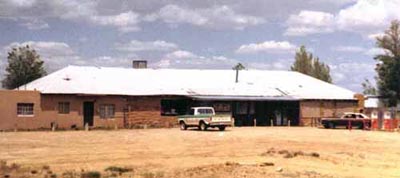
Established 1897
Welcome to the original, the only, the authentic
“Home of the famous Two Grey Hills Navajo rugs”
Two Grey Hills Trading Post
PO Box 2639
Farmington, NM 87499
(505) 860-5553
Each year, since the big Centennial Celebration in 1997, Two Grey Hills has held an annual "Birthday + 100" celebration. Check this space for the next event, and read about the millennium birthday, as reported in the Albuquerque Tribune.

Two Grey Hills Trading Post, over a century old, and one of the few remaining historic posts on the Navajo Indian Reservation, is the primary source of authentic regional rugs and tapestries. Made of hand spun yarn from the fleece of naturally colored local sheep in shades of gray, brown, black and white, they are known around the world as the finest in Navajo weaving.
New life styles and technology have endangered this isolated old general store, the hand spinning, and even the Churro sheep. Most traditional trading posts have long since fallen into ruin or moved to where they could become tourist stops. Most Navajo rugs today are woven of commercial yarns from wool grown far from Dinetah.
This original stone and adobe store in northwest New Mexico, still serves the local Dine community, supplying their needs and buying their arts and crafts. Just a few Bilagaana each week seek out this unique site, between the Chuskas and the Chaco. It is a living museum, but not frozen in time.
To visit this genuine centennial trading post near the Four Corners, travel just 15 minutes off US 491, an hour southwest of Mesa Verde, between Shiprock and Gallup.
Rural trading posts serving as general stores and community centers for small local areas of the Navajo reservation sprouted like mushrooms in times past. Most faded back into the earth just as quickly. Very few have survived through several generations to remain open today. Fewer still have continued trade in the goods produced by their local artists. From the handful of such living relics still in existence, one or two disappear each year. Like the songs and ceremonies, this unique part of Native American history will soon vanish.
In the ubiquitous pick-up truck Navajo families now travel to modern malls for shopping and to tourist shops along the highways to sell their goods. Passable roads crisscrossing the Colorado Plateau have made it possible for city "traders" to scour the reservation for crafts which are wholesaled to tourist "trading posts" far from the reservation.
The Two Grey Hills Trading Post, New Mexico's best kept historical secret, is unaffected by tourist travel. Operating in isolation for over 90 years with no identifying signs, it is well known only to Navajos. Now listed on the New Mexico State Register of Cultural Properties, it welcomes a few visitors and collectors among the quiet flow of regular customers. From the bench on the front porch, a cross section of Navajoland can be observed. Young professionals in modern dress stop here, along with the traditional non-English speaking folk.
The trading post has changed slowly over the years to serve the needs of the community. All the essentials are here, from microwave sandwiches and Huggies to kerosene lamps, enamel pots, fresh mutton, and washboards. Neighbors drop by to pick up their mail or cash a check. They may bring pinon nuts, wool, handmade weaving tools, or rugs and other arts to sell or trade. A few locally made pots, mud toys, wedding baskets, and miniature looms are usually on hand. Some whimsical one-of-a-kind items appear, such as the recent model hogan and sandpainted skull.
Other early trading posts that gave their names to regional Navajo rug styles have disappeared or moved to the highway. The extraordinary popularity of the Two Grey Hills blankets, rugs, and tapestries has kept this store alive for over 100 years. Although surrounded by evidence of Anasazi settlement 1000 years ago, archaeologists and anthropologists have passed on through. Only Tony Hillerman has stayed long enough to create a tale set at Two Grey Hills. Compared to TGH, Lynchburg, Tennesee looks like the state fair on Saturday night!
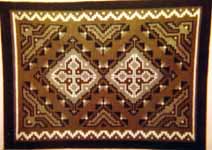
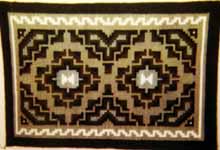
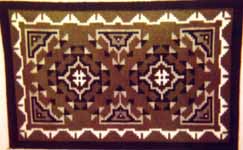
Since the early 1900s the weavers in the Two Grey Hills region, with the guidance of the traders, have produced rugs that are recognized everywhere as the pinnacle of the art. Artists here have challenged each other to spin the tightest yarns and to create the most intricate designs on their looms. Their trademark colors are the natural colors of the local sheep; grays and browns, white and black.
While handspinning is almost extinct in other parts of the reservation, about half of the weavers here still handcard their wool and spin it on the traditional spindle. The Two Grey Hills trader pays a premium for rugs made of handspun wool and stamps the back of the tag. He refuses to stock the commercial yarn that is popular at other trading posts. Instead he continues to sell hand carders and scissors-like clippers for sheep shearing.
Weavers all over the reservation, and off, now copy the Two Grey Hills style rug, but usually substitute mill-spun yarn that is commercially dyed to resemble the natural sheep colors. The brown sheep are particularly rare and their colors cannot be achieved with synthetic dye. The subtle shades of local wool fleece, along with the excellent spinning and weaving skills developed here, make the true Two Grey Hills rug impossible to duplicate.
Weavers who bring their rugs to the trading post are paid a generous price for their work. The rugs are then offered for sale at prices considerably below those charged in shops and galleries. They are not shipped to wholesalers or to a showroom in town. There are no cryptic codes or perpetual sales. One low price applies to both collector and dealer every day of the year.
Because the best rugs are not skimmed off for galleries, and because some rough rugs are purchased to help a weaver's family through tough times, the very finest and the most humble rugs appear in the rug room side-by-side. Small floor rugs or saddle blankets for $90 and museum quality tapestries for $15,000 may be in stock. It is easy to see the differences in size and amount of detail, in the fineness of the spinning and the skill of the weaving, and in the overall appeal of the designs that contribute to the value of each rug. All the rugs at Two Grey Hills Trading Post are attractively priced and the buyer knows the rug is genuine. A purchase helps to preserve weaving history.
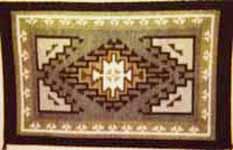
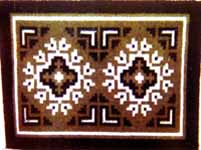
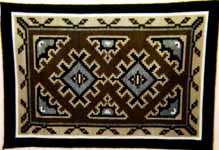
Take a leisurely sojourn through the homeland of the Two Grey Hills weavers.
Between the cottonwood studded farms of Newcomb and the dark pine covered slopes of the Chuska Mountains stand several light-colored promontories. Depending on your vantage point, you may see one, two, three or more "hills", all tan. Inquire locally, "Which are the Two Grey Hills?" and you will get as many opinions and shrugs as the number of people you ask.
Perhaps the rug designs are inspired by the harsh, desolate land. Patterns may be suggested by the Anasazi potsherds that litter the ground, along with broken glass and petrified wood. Watch for bands of hardy desert sheep of many colors whose wool is used undyed in the coveted natural color rugs. Their Churro ancestors came here with the Conquistidores.
The corrals and rural homesteads of nearby Navajo families often blend into the broken terrain. Pick-up trucks have replaced wagons, but horses are still prized possessions. On the open range land you may share the road with livestock of all sorts. Pedestrians wearing jeans and cowboy hats or velvet and calico may be headed for the trading post, too. Since the last century, traders at Two Grey Hills have shared the concerns of these people. They help each other survive … and together they have developed a long-standing weaving tradition of unsurpassed quality.
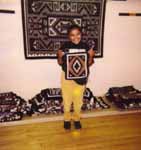
29.7 miles south on US 491 to milepost 59.3 turn right, west, toward Toadlena, on Navajo highway 19, a blacktop road. After 7 miles, pass a housing project on the right. Turn left, south, through the cattle guard onto the new blacktop. After 3 miles, pass the chapter house and buildings on the right, see the back of the trading post at the top of the hill, continue across the wash, through another cattle guard, to a left turn onto the old road to Newcomb, and another left into the rutted front parking lot.
59.3 miles north on US 491 to Navajo highway 19, (described above), turn left. OR turn left at Newcomb and follow the rocky road 6 miles to the front parking lot (look for gas pumps). Put fillings back in teeth.
Find us on Google Maps
Monday thru Saturday, 8 am-6pm or by appointment. If the store is closed, rug buyers should drive to the rear and honk persistently.
Two Grey Hills Trading Post, PO Box 2639, Farmington, NM 87499
(505) 860-5553
© 1991 - 2020 Two Grey Hills Trading Co.
For questions or comments about this site, please send mail to: webmaster@twogreyhills.com